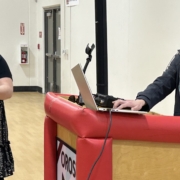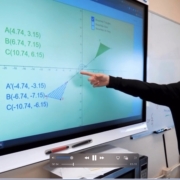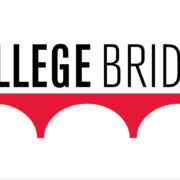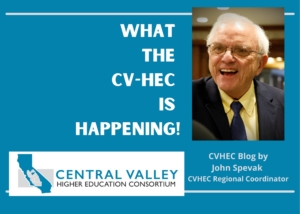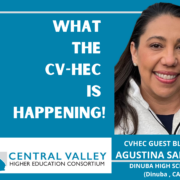Tag Archive for: College Bridge
HIGHER ED NEWS: College Bridge to expand Math Bridge; CVHEC Transfer Project
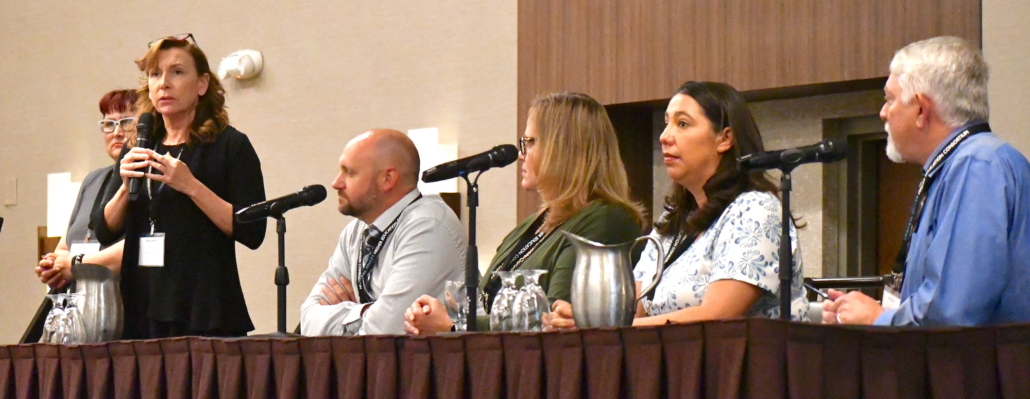
College Bridge President Dr. Lynn Cevallos speaks at the Math Bridge kick off in Fresno May 18, 2023.
College Bridge funded $2.1 million to expand Math Bridge
the ‘Central Valley way’; collaborate with CVHEC Transfer Project
The College Bridge Program, a partner of the Central Valley Higher Education Consortium, has received a $2,196,928 federal grant for expansion of its College Transition Bridge project that, among other features, will advance collaboration with CVHEC’s Central Valley Transfer Project and its college course-planning software, Program Pathway Mapper, as well as with consortium member colleges.
 The College Transition Bridge project is a college counseling initiative created in 2017 that includes a curriculum to meet student needs in preparation for a successful transition from high school to college.
The College Transition Bridge project is a college counseling initiative created in 2017 that includes a curriculum to meet student needs in preparation for a successful transition from high school to college.
With this new three-year grant from U.S. Department of Education Rural Postsecondary Education and Economic Development (RPED) program funds, the College Transition Bridge Project will identify over 2,750 low-income, minority and rural students in the Central Valley to participate in a year-long program that provides students and educators access to college knowledge.
Additionally, the grant will expand the CT Bridge curriculum to include regional workforce needs and streamlined degree pathways to enter the workforce, said Dr. Lynn Cevallos, founder and president of College Bridge, a non-profit organization dedicated to forging a path towards both college access and success for underrepresented students.
“The pathways lead students from high school to community college to the university to career,” she said. “Expanded services are provided to students as well as intersegmental teams of instructors, counselors and administrators.”
She emphasized that “this grant is 100 percent Valley-focused benefiting the identified student population in the California Central San Joaquin Valley.
“And we will be connecting with CVHEC’s proven Central Valley way of doing things as we tie student success to the workforce needs of the region,” she added, explaining that CVHEC leads the partnership efforts connecting workforce needs through aligned college transfer programs between California Community Colleges and the California State University and University of California systems in the region.
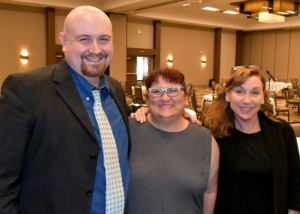
The College Bridge team at the Math Bridge kick off last year: Owynn Lancaster, Dr. Nicole Korgie, Dr. Lynn Cevallos.
College Bridge, based in Southern California but working closely with CVHEC community college members and their feeder high schools in the Central Valley through its Math Bridge Project, is the only California recipient of the RPED program funds awarded Dec. 22 when the Biden-Harris Administration announced $44.5 million in grants to 22 institutions of higher education nationwide.
Funding from the RPED grant program, which promotes the development of high-quality career pathways aligned to high-skill, high-wage and in-demand industry sectors and occupations in the region, is designed to improve rates of postsecondary education enrollment, persistence and completion among students in rural communities.
Cevallos noted that two San Joaquin Valley demographic characteristics drive the need for the federally-funded project: the average per capita incomes are 32 percent lower than the state average; and college graduation rates are 50 percent below the state average.
“Students in the San Joaquin Valley lag far behind in academic performance compared to the rest of the state,” she said. “The region trails the state in bachelor’s degree attainment, with only 12 percent of the adult population holding a bachelor’s degree, compared to 21 percent in the state.”
She said that for associate degree attainment, the region and the state are similar at roughly 8 percent, so this grant opportunity also allows for the revision and expansion of the CT Bridge curriculum regarding:
- Community College Transfer Pathways with an overview of all transfer pathway options but particular focus on the state’s two-to-four-year Associate Degree for Transfer (ADT) Program;
- and the CVHEC Transfer Project’s Program Pathway Mapper (PPM), the software tool that guides students in choosing courses to complete a specific ADT Program.
“In leading the partnership efforts connecting workforce needs through aligned college transfer programs between California Community Colleges and the CSU and UC systems in the region, CVHEC convenes regional partners to review and approve transfer curricula that serve as the basis for the ADT Program,” Cevallos said.
“Faculty from each partner college and university meet to review and approve ADT course requirements. Approved ADTs are loaded into Program Mapper software, which is embedded in College Transition Bridge.”
Dr. Benjamín Durán, CVHEC executive director, said this new endeavor between Central Valley Higher Education Consortium and the College Transition Bridge will streamline and clarify effective college and career pathways for high school students.
“The Central Valley Transfer Project is anchored by the Program Pathways Mapper, a simple, user-friendly but highly effective software platform,” Durán said. “CVHEC will now help integrate the use of the PPM into the college readiness activities provided by CT Bridge as the key planning tool for high school students to identify and chart their pathway to successful completion.”
Cevallos said the math and CT Bridge experience enables students to build their confidence and capacity in math and successfully complete college transfer-level math courses before high school graduation.
“College-level math and English are gateway courses that serve as prerequisites to many other courses important to successful completion and attainment of their desired degree/certification,” she said.
The funding provides the CT Bridge students, while still in high school, a series of college readiness activities such as completing financial aid and admissions applications, reviewing career opportunities in their desired workforce, selecting a major aligned with their desired career interests and planning the necessary sequence of courses, training and timeline for successful completion.
Stan Carrizosa, CVHEC regional coordinator who is the lead for the consortium’s Transfer Project, said
students who benefit from participation in the CT Bridge experience will be introduced to PPM and guided through the readiness details needed for them to plan their college futures from high school to community college and their four-year institution.
“Because so many of the CT Bridge students are first generation college prospects and come from backgrounds underrepresented in college attendance, they often transition to their local community college as their initial pathway into higher education,” Carrizosa said.
He cited the success of a PPM user who was a student panelist at the CVHEC Summit in October.
“Students like Araceli Tilley took full advantage of Program Pathways Mapper by utilizing the course planning software after her transfer from Merced College to continue planning her academic journey at UC Merced where she graduates with a master’s this spring,” Carrizosa noted.
For more information about the College Bridge RDEP grant, contact Dr. Nicole Korgie at nicole.korgie@college-bridge.org.
See:
BACKGROUND: College Bridge’s mission is to identify and eliminate barriers that prevent underrepresented students from progressing to and through college specifically focusing on Black, Latino, low-income and rural students. One of its two objectives is to expand strategic dual enrollment partnerships to serve low-income, rural and Latino students in California’s Central Valley.
WHAT THE CV-HEC IS HAPPENING BLOG (December 2023): The gift of math
For our year-ending “What the CV-HEC is Happening” Blog, here’s a holiday story of sorts by Dr. John Spevak that was published in his column for the Los Baños area (Merced County) newspaper, The Westside Express, Dec. 19. Dr Spevak, who is a vice president-emeritus of Merced College and currently a regional coordinator for CVHEC, coordinates the English and Math Task Forces for the consortium — all champions for student support through such measures as dual enrollment. He provides a personalized window into the founder of College Bridge which is partnering with CVHEC for the Central Valley Math Bridge Program, a math intervention that is utilizing dual enrollment in bringing together consortium community college members with their respective high schools across the central valley.
The gift of math … for students who don’t think they’re mathematical
BY DR. JOHN SPEVAK
CVHEC Regional Coordinator
Vice President-Emeritus – Merced College
Here’s a good question for the Christmas season: What’s the most unusual gift you’ve ever heard of?
I think I have a gift that can top your answer — the gift of math. And I know how that gift can be given—through an innovative program called “Math Bridge,” which before long will be coming to Pacheco High School in Los Banos and later to Dos Palos High School and perhaps Firebaugh High School, too.
Now before all of you who hated math or felt you weren’t good at math skip the rest of the column or sigh in skepticism, let me explain.
Imagine that before you graduated from high school someone had told you that you could be good at math. And imagine further that they enabled you not only to be good at math but to enjoy it and even become passionate about it.
That could have well happened to you if you were a high school student in the Central Valley Math Bridge Program. And your success in math could have opened all kinds of doors for you, in careers related to science, engineering, accounting and computer science, to name a few–careers that are in high demand and pay well.
If you’re still with me, dear reader, your curiosity may have been stirred to the point where you’re now asking, “How in the world can Math Bridge do that?”
Before I answer that question I need to tell you a story. Once upon a time there was a girl in high school, named Lynn, who liked math but didn’t like school, at least the part about being confined to a desk hour after hour each day. She had had some tough times as a teenager, including a period when she was homeless and dropped out of high school at age 15.
One day Lynn, who had decided she should at least get a high school diploma equivalent, started studying math to pass the math section of the GED test and that rekindled her love for math, so much so that after earning her GED, she went on to college and majored in math.
She earned good grades in her college math classes. Along the way she remembered what some middle school and high school teachers had told many students when they said, “You’ll never be good at math.” Sometimes this was said to girls like her, when some male math teachers didn’t think girls could succeed at math.
Not only did Lynn earn her bachelor’s degree in mathematics and secondary education from Boston College, she also went on to earn a master’s degree and then a doctoral degree (an E.D. from UCLA). She soon discovered her purpose in life as she sees it: to show high school students who don’t think they are good at math that they could indeed succeed in math.
She was determined to give them the gift of math.
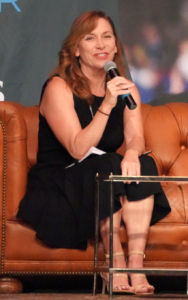
Dr. Lynn Ceballos, president of College Bridge, presenting on the Math Bridge Program at the CVHEC Summit in October.
Dr. Lynn Cevallos eventually started a nonprofit organization called College Bridge about 10 years ago and created a partnership with the Los Angeles Unified School District and California State University Los Angeles, calling it SLAM, the South Los Angeles Math Project, and initiated a nine-year longitudinal study. More than 160 students from six cohorts in three urban LAUSD high schools participated in the project.
In this project Lynn wanted only students who weren’t considered good at math to participate. She needed and received extensive and significant help from high school math teachers and university math professors who worked collaboratively to help students succeed.
They created a program called Math Bridge in which high school students enrolled in a dual enrollment transferable math class while they were in high school.
The results were astounding. The six cohorts of high school students had an average pass rate of 75 percent in a transferable math course compared with an average of 71 percent for the same course taught at CSULA. And the program increased the students’ confidence, with 92 percent considering themselves after completing the program ready for college.
Now Lynn has brought her project to the Central Valley. She has helped create a partnership that involves College Bridge, the Central Valley Higher Education Consortium (CVHEC), Fresno Pacific University and the Rand Corporation to develop the Central Valley Math Bridge Program with eight Central Valley community colleges and many of their feeder high schools.
The colleges who have so far signed on to the project are Cerro Coso, Columbia, Madera, Reedley, San Joaquin Delta in Stockton, Taft, West Hills-Coalinga and Merced.
A number of high schools in Merced County have signed on to the project, including Pacheco High School in Los Banos. Dos Palos High School plans to sign on next year. More might be joining later.
Since West Hills College Coalinga is part of Math Bridge, it’s a good bet that at some point Firebaugh High School will also participate.
The Math Bridge project requires a lot of work not only by Lynn and others who are now part of the College Bridge staff, but also by many high school math teachers and many college math professors.
For this project to work, high school educators need to identify students struggling in mathematics, then design interventions using a blend of college and high school math courses, and then create college and high school instructional teams working collaboratively to analyze student work for continuous improvement.
I’m excited about the project. Over the years as an educator, I’ve heard so many people, young and old, say they’re not good at math and never will be. I believe Math Bridge will change the perceptions of the high school students who will be a part of the project. They will realize they can be good at math.
That will be good for them and their families. And for the state and the country.
We need more young people to go on to college and then into math-based careers, especially in computers, science, and engineering, if we want our country to be the world’s innovative leader in these fields. This will be good for our country’s strength–and its security.
What the CV-HEC Is Happening Blog: Math Bridge Update
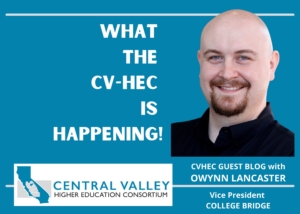 This month’s “What The CV-HEC Is Happening” guest blog is an update of the Math Bridge program presented by Owynn Lancaster, vice president for Academic Strategy with College Bridge, a California non-profit based in Los Angeles County dedicated to forging a path towards both college access and success for underrepresented students. College Bridge is a partner with the Central Valley Higher Education Consortium in the innovative program designed to improve math outcomes for struggling 11th and 12th graders and streamline Math pathways into college. Funded by a five-year $4 million grant through the US Department of Education’s Education Innovation and Research (EIR) Program in January, this ambitious endeavor was kicked off in May with a convening of more than 150 valley K-16 educators in Fresno to begin the onboarding process for this historic intersegmental collaboration between CVHEC member community colleges and high schools in their respective service areas. That initiative was followed in April with a $1.1 million state grant to CVHEC/College Bridge partnership through the Central San Joaquin Valley K-16 Partnership creating the Dual Enrollment (DE) Math Bridge that will provide equitable access to transfer-level math courses with embedded support for high school students who are disproportionately impacted, and/or are not traditionally college-bound. This fall, the College Bridge and CVHEC Math Bridge teams have been visiting campuses to continue the onboard process in preparation for the program’s launch next fall.
This month’s “What The CV-HEC Is Happening” guest blog is an update of the Math Bridge program presented by Owynn Lancaster, vice president for Academic Strategy with College Bridge, a California non-profit based in Los Angeles County dedicated to forging a path towards both college access and success for underrepresented students. College Bridge is a partner with the Central Valley Higher Education Consortium in the innovative program designed to improve math outcomes for struggling 11th and 12th graders and streamline Math pathways into college. Funded by a five-year $4 million grant through the US Department of Education’s Education Innovation and Research (EIR) Program in January, this ambitious endeavor was kicked off in May with a convening of more than 150 valley K-16 educators in Fresno to begin the onboarding process for this historic intersegmental collaboration between CVHEC member community colleges and high schools in their respective service areas. That initiative was followed in April with a $1.1 million state grant to CVHEC/College Bridge partnership through the Central San Joaquin Valley K-16 Partnership creating the Dual Enrollment (DE) Math Bridge that will provide equitable access to transfer-level math courses with embedded support for high school students who are disproportionately impacted, and/or are not traditionally college-bound. This fall, the College Bridge and CVHEC Math Bridge teams have been visiting campuses to continue the onboard process in preparation for the program’s launch next fall.
Expanding the Reach of the
Central Valley Math Bridge
BY OWYNN LANCASTER
College Bridge
After our successful College Orientation meetings in September, the College Bridge team has been darting up and down the San Joaquin Valley, meeting with interested feeder highs schools to onboard and launch them for the coming academic year’s CV Math Bridge Project.
Inspiring our efforts, two amazing CVHEC member colleges have “jumped to lead the pack” as Dr. Lynn Cevallos, our College Bridge president, often says. The first of those with an impressing showing come from Merced College where their team has helped us garner interest from seven possible high schools! Showing the region’s commitment to opening options for their students in math and the impressive connecting power of the college’s administration.
In equally exciting efforts, San Joaquin Delta College helped to secure two committed high school partners from Stockton Unified, with interest from others in their region. Those two Stockton schools, Amos Alonzo Stagg High School and Captain Charles M. Weber of Applied Science and Technology have been two of the smoothest schools to onboard so far! More importantly addition of these schools and the partnership with Delta College now helps us open the CV Math Bridge Project across the breadth of the Valley.
With schools as far north as Stagg High School and as far south as Taft Union High School the reach of this project is now slightly smaller than the state of South Carolina! This means several more flights and drives are still ahead for our College Bridge team to continue to onboard and launch these high school partners, but in the end, we are excited by this transformative work.
The CV Math Bridge’s first cohort of schools will be starting in the coming academic year, 2024-2025, and there’s still room for more in the second cohort starting in academic year, 2025-2026. We invite high schools interested in participating to reach out and contact me at Owynn.Lancaster@college-bridge.org.
Also see: https://bit.ly/CVHECblog1223-GiftOfMath
PRESS RELEASE: Central Valley Math Bridge kickoff May 18 in Fresno
ADVISORY: For media coverage of the Central Valley Math Bridge Kickoff on Thursday, May 18 (9 a.m. to 3 p.m.), or for spokesperson availability, please text Tom Uribes at 559.348.3278. LOCATION: The Doubletree by Hilton Hotel/Fresno Convention Center (2233 Ventura St. – Fresno). See Agenda.
(UPDATE May 26, 2023) – See Math Bridge coverage.
Central Valley Math Bridge: keeping the doors to STEM careers open for our students
13 rural high schools, six community colleges to convene for program kickoff May 18 in Fresno
(May 16, 2023) — The first cohort of 13 Valley high schools has been secured for the Central Valley Math Bridge Program that will promote equity and college-readiness in mathematics via dual enrollment courses for underprepared students at rural high schools in the region next fall (see list of high schools below).
The participating educators will convene this week with six community college members of the Central Valley Higher Education Consortium in Fresno to formally launch the program and plan for its implementation at the Central Valley Math Bridge Kickoff from 9 a.m. to 3 p.m. Thursday, May 18, at Doubletree by Hilton Hotel Fresno Convention Center.
The launch is presented by co-hosts College Bridge, Central Valley Higher Education Consortium and the Rand Corporation.
Dr. Lynn Cevallos, founder and president of College Bridge, will deliver keynote remarks, “The State of Mathematics in California,” an analysis of intersegmental mathematics policies and practices statewide over the last 20 years that highlights a pending crisis now facing Valley students.
“The doors to STEM careers are closing for our students,” Cevallos warned. “The Math Bridge project is designed to keep those pathways open.”
In one morning session, “Collaborating Towards a Common Goal: Dinuba Success Story,” officials from Dinuba High School will share their experience with a previous College Bridge program — the Math Pipeline Readiness Project (M-PReP) — that provided the foundation for the current project.
Presenting will be DHS Principal Andrew Popp, Counselor Auggie Sanchez and Jim Gilmore, Math professor at Reedley College which was the DHS community college partner.
Dr. Benjamín Durán, CVHEC executive director, will deliver closing remarks along with Cevallos.
“The DE Math Bridge Project will prepare and guide students as they transition to college or university equipped with math credits and confidence,” said Durán, president-emeritus of Merced College who became CVHEC’s executive director in 2016. “It creates a model for meaningful dual enrollment pathways and expansion that can be replicated in other regions of California serving underprepared students. This also supports CVHEC’s mission to increase degree attainment rates.”
The Central Valley Math Bridge project was initially funded by a $4 million five-year Education Innovation and Research (EIR) Program federal grant awarded by the U.S. Department of Education to College Bridge in late December.
College Bridge recently completed an extensive four-month recruitment campaign to secure eligible high schools for the first of two cohorts. Recruitment of the second cohort will begin this summer, Cevallos said.
The first cohort of high schools to-date and their respective community college partners are (with three additional pending*):
Cerro Coso College: Lone Pine, Tehachapi;
Columbia College: Bret Harte*, Calaveras*;
Madera College: Liberty, Madera, Madera South, Matilda Torres, Yosemite;
Reedley College: Dinuba, Orosi, Parlier, Reedley*
Taft College: Taft High School
West Hills Coalinga College: Firebaugh, Tranquillity.
High schools and community colleges interested in participating in the second cohort may contact Nicole Korgie at nicole.korgie@college-bridge.org.
For more information about the May 18 event, contact Angel Ramirez, CVHEC operations manager at 559.292.0576 (centralvalleyhec@gmail.com). Media inquiries: Tom Uribes at 559.348.3278.
NOTE: A parallel project funded by the state in February through the Central San Joaquin K-16 Partnership — made up of the Fresno/Madera and the Tulare/Kings K-16 Collaboratives — will serve an additional two colleges and seven high schools in the region (see https://bit.ly/CVHEC-DualEnrollmentMathBridge).
See background stories
https://bit.ly/CB-DualEnrollmentMathBridgeAnnounced
https://bit.ly/MathBridgeDualEnrollmentKickoff
UPDATES
- What the CV-HEC Is Happening Blog: Math Bridge Update
- “What the CV-HEC is Happening” Blog – The Gift of Math
ABOUT CVHEC and COLLEGE BRIDGE
The Central Valley Higher Education Consortium based in Fresno, made up of 28 institutions of higher education in the Central Valley’s nine-county region, is assisting the Dual Enrollment Math Bridge Project by using its role as a regional convener to bring the participating higher education and K-16 representatives together with College Bridge, a California non- profit based in Los Angeles County dedicated to creating a seamless K-16 pathway for students.
AGENDA-MathBridgeKO(051823)media
CVHEC IN THE NEWS: College Bridge Dual Enrollment Math Bridge Project featured on KERO23
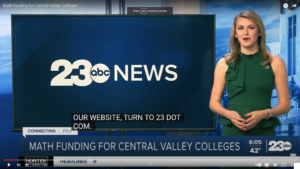 The College Bridge Dual Enrollment Math Bridge Project, in partnership with the Central Valley Higher Education Consortium , was featured by KERO23-ABC in Bakersfield with reporter/anchor Ava Kershner interviewing Dr. Lynn Cevallos, founder and president of College Bridge, and Armin Rashvand, the Taft College dean of instruction.
The College Bridge Dual Enrollment Math Bridge Project, in partnership with the Central Valley Higher Education Consortium , was featured by KERO23-ABC in Bakersfield with reporter/anchor Ava Kershner interviewing Dr. Lynn Cevallos, founder and president of College Bridge, and Armin Rashvand, the Taft College dean of instruction.CVHEC IN THE NEWS: College Bridge Dual Enrollment Math Bridge Project
WHAT THE CV-HEC IS HAPPENING GUEST BLOG (February 2023): College Bridge and Dinuba HS
This month’s “What The CV-HEC Is Happening” guest blog is presented by Agustina Sanchez, a counselor at Dinuba High School in Tulare County who has participated in the College Bridge Math Pipeline Readiness Project (M-PReP) since it was implemented in 2013. During the three-year project in concert with CVHEC-member Reedley College, Dinuba students not only acquired the necessary skills to become college-ready, but also passed college-level math classes through M-PReP, all in the span of their senior year. Mrs. Sanchez, who earned a bachelor’s degree at Fresno State in 2001 and master’s and PPS Credential in 2003, has been counseling for 19 years. Here she shares her experience with College Bridge and how its life-changing strategies helped high school students through initiatives such as M-PReP and its new Dual Enrollment Math Bridge Project announced last month.
Hard Pass? No more!
A rural Central Valley high school teams with College Bridge and
a CVHEC member for student math success through dual enrollment
BY AGUSTINA “AUGGIE” SANCHEZ
Dinuba High School – Dinuba CA (Tulare County)
Hard Pass! This was the typical response I received when registering high school juniors for a senior year math experience.
AP Calculus? AP Statistics? Pre-Calculus? No. No Way. Hard Pass!
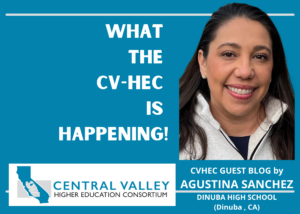 As a high school counselor, I knew that our college-bound students were going to see math again (and, most likely, again and again). I did everything in my power to get college-bound students to take a math course, and while some took my advice, many did not because they “didn’t want a hard senior year,” or they would “just wait and take their next math in college.”
As a high school counselor, I knew that our college-bound students were going to see math again (and, most likely, again and again). I did everything in my power to get college-bound students to take a math course, and while some took my advice, many did not because they “didn’t want a hard senior year,” or they would “just wait and take their next math in college.”
In fall 2018, I was introduced to a new partnership for Dinuba High School (DHS) with College Bridge. The goal of this partnership was to increase the number of students in a senior math experience, namely Dual Enrollment (DE) Math.
The concept was actually quite simple.
DHS partnered with a local community college to offer Dual Enrollment (DE) math courses to our seniors in areas of statistics, college algebra, college trigonometry and calculus. College Bridge literally created a bridge between DHS and Reedley College to ensure our students’ success in this area. Our senior students enrolled and successfully completed these DE math courses with a C or better, many of them finishing their general education math for their bachelor’s degree while still high school students.
To build a foundation for student success, College Bridge created a system of support in all areas — administrative, instruction, counseling and student learning:
- To train in course curriculums, from statistics to calculus, DHS teachers received professional development in cohort with Reedley College professors.
- Reedley College faculty not only came to mentor our teachers, but they were also released from the college to come and teach weekly at DHS while our teachers observed.
- Reedley College faculty members then observed our teachers in action and guided them throughout the semester until our instructors demonstrated comfort in, and a comprehensive understanding of, curricular content and methodology.
- To engage students, a counseling mentor was provided to help promote, market, entice and enroll students into courses.
- Parent nights were held, classroom presentations were conducted in Math 3 classes, and College Bridge helped interested students complete the necessary steps to apply to Reedley College.
- Our DHS math instructors taught the Reedley College content three days a week, offered tutorials the other two days, and additional after-school assistance was available three times per week.
- Students were monitored and interventions applied early to ensure positive student learning outcomes.
DHS now had a new approach and convincing talking points to encourage students to enroll in a senior math experience:
- Do you want to complete your math for your bachelor’s degree here at DHS?
- This is your chance to complete your first year of calculus at DHS with the support of our teachers.
- Why wait until you get to Reedley College or Fresno State; this is your chance to finish your math here at DHS with your teacher’s support and interventions.
Needless to say, senior math enrollment increased.
In our first year of implementation, DHS just focused on Math 11 (Statistics). College Bridge took things a step further, deeply investing efforts in the “striving math student.” A pre-Statistics course was offered in the fall and then the magical Math 11 (statistics) DE in the spring, thus preparing students for a full semester before enrolling them into the DE course.
Our more advanced students took the Math 11 DE in the fall term, and a Quantitative Reasoning course in the spring (non DE). DHS senior students achieved their goal and entered college “math done” for their degrees. Over the next three years, DHS added algebra, trigonometry and calculus to DE math course offerings.
Now, nine years after the first implementation of College Bridge, dual enrollment math is still strong.
We have two full-time teachers who teach DE courses for a total of 10 sections and are currently registering current 11th graders for next year. Our student math conversations are not difficult; many students have already made a DE math choice, and compelling arguments and evidence — including the pros and cons of dual enrollment math — typically convince those students who are hesitant to choose the path to college credit.
The senior math experience “hard pass” era is no longer viable. Instead, our current students will “hardly pass” up this amazing opportunity to excel.
(UPDATE May 26, 2023) – See Math Bridge Kickoff May 18 coverage.

